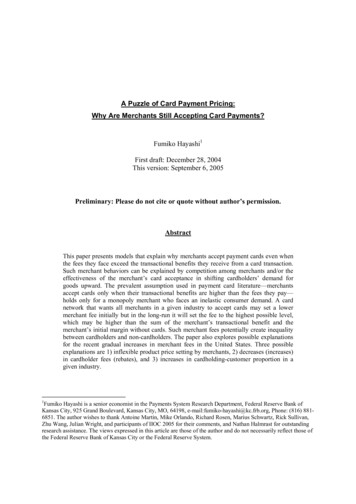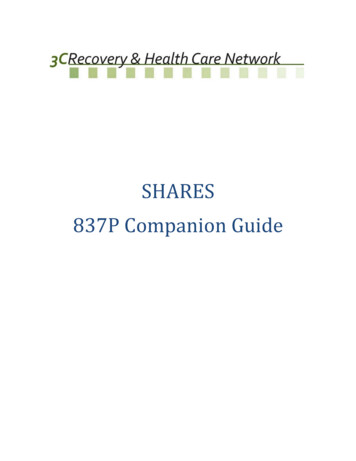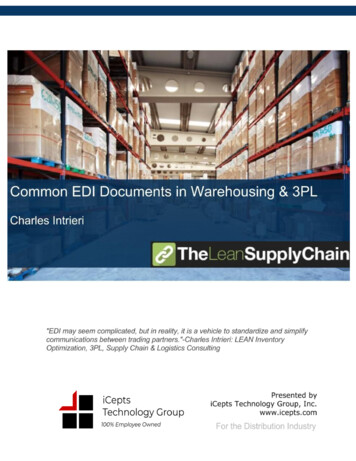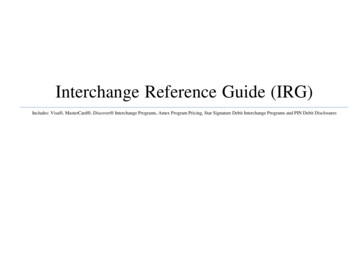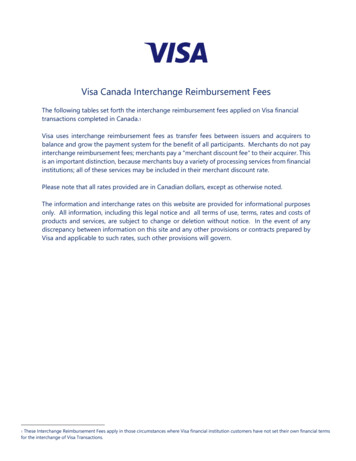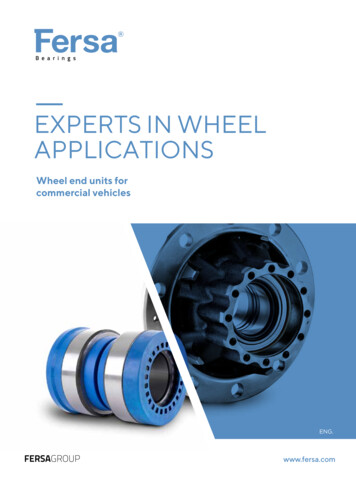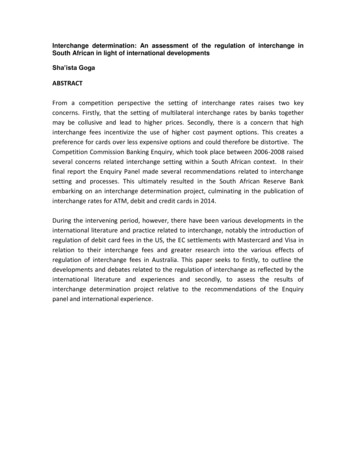
Transcription
Interchange determination: An assessment of the regulation of interchange inSouth African in light of international developmentsSha’ista GogaABSTRACTFrom a competition perspective the setting of interchange rates raises two keyconcerns. Firstly, that the setting of multilateral interchange rates by banks togethermay be collusive and lead to higher prices. Secondly, there is a concern that highinterchange fees incentivize the use of higher cost payment options. This creates apreference for cards over less expensive options and could therefore be distortive. TheCompetition Commission Banking Enquiry, which took place between 2006-2008 raisedseveral concerns related interchange setting within a South African context. In theirfinal report the Enquiry Panel made several recommendations related to interchangesetting and processes. This ultimately resulted in the South African Reserve Bankembarking on an interchange determination project, culminating in the publication ofinterchange rates for ATM, debit and credit cards in 2014.During the intervening period, however, there have been various developments in theinternational literature and practice related to interchange, notably the introduction ofregulation of debit card fees in the US, the EC settlements with Mastercard and Visa inrelation to their interchange fees and greater research into the various effects ofregulation of interchange fees in Australia. This paper seeks to firstly, to outline thedevelopments and debates related to the regulation of interchange as reflected by theinternational literature and experiences and secondly, to assess the results ofinterchange determination project relative to the recommendations of the Enquirypanel and international experience.
Interchange determination: An assessment of the regulation of interchange inSouth African in light of international developmentsOutside of cash transactions, most payments made within South Africa utilise theservices of one or more banks in order to transfer value from one party to another.Where the parties have different banks, each bank generally levies their customer fortheir services in affecting this transfer. This is generally referred to as interchange. Moreprecisely, however, the South African Reserve Bank (SARB) defines interchange in thecontext of payment systems to be “the process whereby banks, through their devices,systems and procedures, facilitate the acceptance, collection, exchange, clearance andsettlement of payment instruments utilised by their customers within the NationalPayment System” (SARB, 2012).Interchange is used across various types of payment streams including automatic tellermachine (ATM), debit and credit cards, and electronic fund transfers. Interchange hasmost commonly been analysed and discussed within the context of credit and debit cardpayments made through what is termed a four party payment model (the four partiesbeing the customer, the customer’s bank, the merchant, and the merchant’s bank). Inthis model, if a consumer wishes to buy a product or service, they would present theircredit card to the merchant, who swipes the card through a Point of Sale (POS) deviceprovided by or connected to the merchant’s bank. The merchant’s bank then sends amessage to the payer’s bank to deduct that amount from the payer’s account. Thepayer’s bank then pays the amount requested less the interchange fee to the merchant’sbank, which then deducts a further fee before depositing the funds into the merchant’saccount.Interchange rates vary considerably between different payment streams. Furthermore,interchange does not always flow in the same direction: interchange flows from payers toreceivers in the case of credit electronic fund transfers (EFTs) while interchange flowsfrom receivers to payers in the case of payment card interchangeFigure 1: Four party payments system modelPayer’sbankPayerATM: R3.48 & 0.53%Credit card purchase: 1.41-1.89 %Debit card purchase 0.55%Source: Volker, 2013, SARB 2014Recipient’sbankRecipient
Interchange has been a subject of contention from a competition perspective for variousreasons. Firstly, there are concerns that the setting of multilateral interchange rates bybanks together may be collusive and lead to higher prices. This is particularlya concern if banks are incentivized to set fees at a profit-maximising level,beyond the level required to promote card usage. This is likely to be passedthrough to customers in the form of higher prices for customers using both cardsand cash. Secondly, there is a concern that high interchange fees incentivise use ofhigher cost payment options. Interchange subsidises cardholders so they donot pay the marginal cost of card usage. This creates a preference for cards overless expensive options and could therefore be distortive.During the Banking Enquiry the panel made various recommendations related tointerchange for ATM and card services. This included the following:1. That ATM carriage or interchange is removed and ATM networks move to adirect charging model (“DCM”).2. That all interchange rates should be set at the lowest level possible. This shouldbe based on a “new independent, objective and transparent regulatory processfor interchange in payment card and payment streams” (Banking Enquiry Report,pg 236). The process should be participatory, be independently assessed on thebasis of audited data and be overseen by regulators with public disclosure of allinterchange agreements. It would be based on the development of aninterchange forum open to all stakeholders that would determine the optimal levelof interchange for each stream by developing general criteria, and gettinginformation on costing (through a third party costing study) and demandelasticities. Decisions would be made by consensus or by the chairperson withreasons provided. There would also be an appeal procedure.After the Banking Enquiry concluded, various stakeholders including the NationalTreasury and SARB agreed on the importance of determining an interchange process.However, there was debate over the form that it should take. It was decided that insteadof an interchange forum made up of stakeholders the SARB would facilitate and overseea revision of interchange rates for all payment streams (supported by NT and CC). Thisprocess is currently being undertaken and between December 2013 and March 2014 theSARB published new interchange rates for both card-related streams (SARB, 2014) aswell as ATM transactions (SARB, 2013).The Banking Enquiry took place between 2006 and 2008. At that time the internationalexperience in regulating interchange was somewhat limited. In the years between 2008and 2014 there have been various developments internationally in terms of theregulation of interchange. This has resulted in varying experiences and allowed forgreater breadth and depth of research on this topic. Two key developments that havestimulated much debate and research are the following:1. The regulation of debit card interchange by the Federal Reserve in the US: In2011 a legislative amendment1 was made to direct the Federal Reserve Board toregulate debit card interchange so that it is “reasonable and proportional to the1This is known as the Durbin amendment to the Dodd-Frank Act
cost incurred by the issuer”. This regulation limits the maximum interchange ratethat an issuer could get from merchants in a debit card transaction.2. The Mastercard and Visa decisions in the EU: After scrutiny from competitionperspective the European Commission reached settlements with Visa andMastercard allowing multilateral interchange fees of 0.20% for debit cards and0.30% for credit cards using the “tourist test” (discussed in more detail later).These and other attempts to regulate interchange, including the Australian experience inregulating interchange since 2003 has led to an expanded range of literature anddiscussion on the topic. In particular, the literature has grown in the following two areas.1. The first relates to the appropriate test for setting fees. In particular, thedevelopment of the “”tourist test” (also known as the “avoided cost” or “merchantindifference test”), discussions of the validity and relevance of these tests andempirical derivations of the fee that this test implies (ultimately used in theMastercard settlement).2. The second development has been increased testing of both the benefits and theunanticipated consequences of regulation in jurisdictions in which it hasoccurred. This has provided greater insight into the workings of interchangeregulation in different contexts and its impact on card companies, prices andconsumers.This paper is structured as follows: Firstly, we provide a brief review of selected developments in the internationalliterature relating to interchange determination subsequent to the bankingenquiry. Secondly, we outline the SARBs interchange determination process. Finally, using this background we discuss the SARBs approach to interchange inlight of both the Banking Enquiry and international developments.This paper focuses on the debit and credit card payment streams.1.1 Interchange in the context of international developmentsThere have been various developments related to interchange internationally since theBanking Enquiry. Interchange regulation has occurred both in the US and in the EU, theformer as part of a regulatory process, and the latter as a result of competition concernsand settlement negotiations. In addition, as time has passed since the introduction ofregulated prices in Australia, there has been increased opportunity to assess theconsequences of that legislation. In terms of theory, a key area of discussion and debatehas been on the appropriate methodology to use to determine interchange rates and hasfocused on the use of the “tourist test” as opposed to a cost-basis.It is generally agreed that interchange rates set privately are not likely to reflect theoptimal rates. The theoretical literature notes a host of factors that determine the optimalinterchange fee. These include the following (Evans 2011, Prager et al 2009): elasticities of cardholders, network effects between merchants and customers, transaction costs marginal costs competition in the issuing and acquiring side and price distortions in competing systems
However, it is generally agreed accepted that in most instances this data is difficult tocome by, and estimation methods that incorporate the various facets have not beendeveloped. As such, setting an optimal or appropriate interchange rate is extremelycomplex.This complexity has led some economists to recommend that interchange is notregulated at all, as it is not possible to determine a correct price (Evans 2011). However,there are two key types of methodologies that have been applied in differentjurisdictions.A) A cost-based regulation of interchange (as used in Australia and the US)B) The tourist test (used in the EU)Cost-based regulationCost based regulation has been used in Australia for both credit and debit cards and inthe US in the regulation of debit cards: The regulation of debit card interchange by the Federal Reserve in the US:In 2011 an amendment was made2 to direct the Federal Reserve Board (“theFed”) to regulate debit card interchange so that it is “reasonable and proportionalto the cost incurred by the issuer”. This regulation limits the maximuminterchange rate that an issuer could get from merchants in a debit cardtransaction. The legislation therefore specifies regulation solely on the basis ofcost. The fees are set based on the Fed’s evaluation of the costs associated withdebit card fees. It explicitly specifies the incremental cost of processing,clearance and settlement. It furthermore allows for additional costs not specifiedand makes allowance for the consideration of various fraud and security factors.It exempts small issuers, government administered payment programmes andprepaid cards. The fee ultimately published as a result of this process is a fixedfee for processing costs (set at 21c), and an ad-valorem adjustment for potentialfraud losses and fraud prevention costs (1c). The regulatory framework providedin the Durbin amendment has been criticized on the grounds that it was rushedthrough and contrary research published by economists at the Fed who state thatthere is no justification for cost-based regulation of interchange (Evans 2011,Prager et al 2009). This is discussed later. Reforms by the RBA: The Reserve Bank of Australia introduced a number ofreforms to their credit card market in 2003, a key reform being the reduction ofinterchange rates. This was done on a cost basis with a cap on the weightedaverage interchange fee. Card companies still have flexibility to set differentinterchange rates for different types of transactions as long as the weightedaverage falls within the cap.The use of a cost-based methodology in these jurisdictions has generated substantialcontroversy. On the one hand, it is argued that from a theoretical perspective there is noevidence that a cost based measure would be an optimal or even second best form ofregulation (Prager et al, 2009). Furthermore, it is argued that this regulation results invarious unanticipated consequences.Empirical work suggests that the reforms resulted in the following:2This is known as the Durbin amendment to the Dodd-Frank Act
1. Changes to circumvent the regulations were made. Card issuers made changes to product offerings and pricing. This includereducing reward points and benefits to cardholders and increasing card fees.Wang (2012) quotes US studies that suggest that a large proportion of debit cardissuers either did or plan to discontinue rewards plans. In addition, in the US onesurvey showed that non-interest checking account fees increased by 25% andthe minimum balance for free-checking services rose by 23% due to factorsincluding the interchange regulations. There is some evidence that Australianbanks also increased fees to customers and reduced rewards following thereduction in interchange (Evans, 2011). Since card companies had differential interchange prices for standard andpremium cards it also resulted in banks upgrading customers or otherwiseencouraging the use of premium cards with higher interchange fees.2. In the US merchants were affected asymmetrically.Interchange fees rose for smaller ticket merchants who had previously benefitedfrom a discounted interchange fee to encourage card acceptance for small ticketitems. However, post-regulation this changed so that all transactions were subject tothe the maximum capped amount. This resulted in small ticket merchants raisingprices, encouraging alternative means of payment or dropping card payments.However, this is specific to the structure of the regulated fee (a fixed fee rather thanan ad valorem). (Wang, 2012)3. A redistribution of interchange revenue from issuers to merchants. This has beensupported by empirical work which suggests limited evidence of past-through insome contexts. For example, some literature argues that the reforms madeconsumers in Australia worse off since there was little evidence of a pass-through,and that pass-through was unlikely in any instance given the concentrated nature ofretail in Australia. The argument made is that the reforms led to increased card feesand reduced rewards for consumers, and that merchants kept a windfall from thereduced interchange rates (Evans, 2011).Concerns have also been raised that a cost-based regulation, in setting a level that istoo low, reduces incentives for innovation (Evans, 2011).At the same time, arguments made in support of such cost-based regulation ofinterchange were also made, and include the following:1. That it improves transparency and implementation is straightforward.2. That merchant service fees decline. This addresses the core concern that prices aretoo high.o That the decline in prices could increase merchant acceptance of cards. Theimportance of this depends on the extent to which cards are accepted.o That the decrease in fees reduces the merchant cost base and may be passedthrough to customers. The extent of pass-through is a function of thecompetitiveness of the retail environment.3. That while card fees may rise this provides better price signals and thereforeincentivizes use of more cost effective payment methods.A review by the RBA in 2008 concluded that their key objectives were met which wasincreased transparency, improved competition (by removing restrictions on merchantsand liberalizing access) and more appropriate price signals.
As such, evidence from Australia and the US supports the theory that lower interchangerates (using a cost basis) provide better signals for customers. However, there iscontroversy as to whether the reforms led to reduced consumer surplus to the benefit ofretailers.The alternative methodology that has been used internationally is the “tourist test”, alsoknown as the “merchant indifference test” and the “avoided cost test”.The tourist test was proposed by Rochet and Tirole in 2007. They show that undercertain conditions an interchange fee may exceed the optimal level. If it is too high, amerchant who accepts card payments may turn down the card payment of a non-repeatcustomer (the tourist) who has both cards and cash in order to reduce operating costs.However, from a societal point of view it would have been better if this customer hadused his card. They therefore propose a benchmark for regulatory intervention thatrequires that the fee does not increase the merchant’s net operating cost relative to cashacceptance. It is therefore an interchange level that renders merchants indifferentbetween different means of payment and therefore internalizes externalities. Literaturehas shown that the tourist test is allocatively identical to perfect surcharging bymerchants.Much of the literature supports the conclusion that a regulated interchange fees shouldnot lie below the level set by the “tourist test”, which has been termed a “conservativeregulatory benchmark” (Rochet and Wright 2010). It should be at least equal to thedifference between the merchant’s benefit from card usage and the acquiring costs.However, this may be too low if:1. It does not reflect profit and therefore has a long-run impact on entry, innovationand end-user welfare2. It does not reflect negative social externalities of other uses of payment (eg. cashpreference due to tax evasion)However, there are complexities in setting this rate too. For example, there aresuggestions that the correct alternative may not always be cash. Rochet and Wright, forexample note that for credit cards the cap on the level of interchange should be the costof providing store credit rather than the cost of cash.In 2007 the EC ruled that Mastercard’s multilateral interchange fee (MIF) violatedcompetition policy. Subsequently, the EC DG Comp provided a list of criteria, whichneeded to be met in order for a multilateral interchange fee to fulfill exemption criteria.These were to demonstrate:1. empirical proof that the MIF creates efficiencies that outweigh the restriction ofcompetition2. consumers get a fair share of those benefits3. there are no less restrictive means of achieving the efficiencies and4. competition is not eliminated altogether.This would be assessed by the Commission who would ascertain that that the “concretemodel” underlying a multilateral interchange fee is based on realistic assumptions, isplausibly implemented through an objectively verifiable methodology and that it yieldsthe objective efficiencies on the market claimed by the parties. They also state that themethodology underlying the interchange fee should be transparent to the final users of a
scheme (EC Memo/07/590).Mastercard ultimately responded to the regulations by choosing to set its interchangerates based on the “tourist test” or the merchants cost of accepting a card against theircost of accepting cash. This was based on studies by the central banks of Belgium, theNetherlands and Sweden. It resulted in the European Commission approvingsettlements with Visa and Mastercard that allowed interchange fees of 0.20% for debitcards and 0.30% for credit cards for cross-border interchange fees.However, the tourist test too has its critics and the EC themselves state that the touristtest has limited applicability noting the following:1. That while a MIF at appropriate levels makes the use of efficient payment instrumentsmore attractive to consumers other (less-restrictive) mechanisms may do so as well insome markets. They provide the example of merchants themselves incentivizing the useof less costly payment instruments by applying rebates to those means of payment. Inthis case it is stated that a MIF may not be indispensible, as direct incentives given bymerchants may internalise network externalities between merchants and users ofpayment instruments more directly.2. That when payment cards reach universal usage in a market without MIF, the need tohave interchange to promote the issuing of cards (in terms of network effects) wouldvanish.3. That there must be a reasonable channel through which interchange fees can promotethe use of cards. For example, they note that reward programmes for debit cardstypically do not exist and that cardholding is already widespread (but not complete).Therefore, the DG Competition does not consider that possible future increases of the'tourist test' estimation for debit cards would necessarily justify an increase in the debitcard MIF, unless payment card associations can ensure that the banks receiving such ahigher MIF have installed appropriate cash-back programs for debit cards that coulddirectly incentivise a wider use of debit cards on a per-transaction basis.1.2 The SARB Interchange Determination ProjectBased on the recommendations of the Banking Enquiry, which called for a new objectiveand transparent regulatory process to set card interchange, the CompetitionCommission, the National Treasury and the SARB decided that interchange rates wouldneed to be reassessed. The SARB was tasked with overseeing a process toindependently determine interchange rates, subsequently named the interchangedetermination project (IDP). The project had two phases.The first was a review of interchange rates in all payment streams. The second phasewas a project to evaluate and determine the costs of providing payment services in aparticular payment stream and determining an appropriate interchange rate for theindustry. The second phase of the IDP was undertaken by KPMG under the oversight ofthe SARB. The project thus far has centered on two payment streams, ATM and cardrelated streams. This resulted in the determination of ATM interchange fees inDecember 2013 and the publication of the results of the card phase, encompassingtraditional cards (debit, credit and hybrid), self-service devices, over the countertransactions and cash-back at point-of-sale, in March 2014.
The summary published by the SARB on 20 March 2014 states that, based oninteraction with various stakeholders and investigative research, it was ultimatelydecided that a cost-based methodology would be used. The guiding principle used in theanalysis was “the safety and efficiency of the National Payment System”. (SARB Mediarelease, 20 March 2014)The final rate published by the SARB is described as being based on the true cost ofinterchange. In addition, the SARB concluded that the current definitions and structurewere dated and did not cater for what is termed “elements of growth, innovation andsecurity”.One of the decisions taken was to increase the number of tiers to allow for differentincentive structures. The project team also looked at additional topics including whetherspecific interchange rates were required for fuel, government and low-value payments,and to clarify card-related issues such as definitions.The costing methodology used was as follows:1. The minimum costs incurred were used.2. Only costs that were beneficial to cardholder and merchant were included.3. Standardised costs for reducing risk in the card payment system were used.In addition factors such as access to financial services, stability, innovation, andconcerns over safety features were considered.In terms of definition and structure there were two key changes:1. Hybrid and debit cards were collapsed into one category. This was based ontheir similarity in both function and cost.2. The tiers for interchange rates were increased from 3 levels to 12 levels. Theapplicable tier is determined as follows:a. Card classification: Is the card a debit or credit card? The base rate isbased on the general costs of debit or credit card.b. Nature of transaction and associated risks: Is the card present atpurchase or not? A margin is added based on the risk of a card beingpresent or absent.c. Security behaviour incentives: Is the card issuer, acquirer, or both 3Dsecure or EMV compliant? This provides an additional margin to driveadoption of safer systems namely EMV and 3D secure compliance whichhave anti-fraud security.The resulting rates are as follows:
CreditDebit card Debit cardcardbeforeafterbeforeCreditcard after0.55%0,44%1.71%1,48%Card-present purchase (only the issuer is EMV0.55%compliant)0,52%1.71%1,55%Card-present purchase (only the acquirer is EMV0.55%compliant)0,36%1.71%1,41%Card-not-present purchase (issuer and acquirer is0.55%3D Secure compliant)0,48%1.71%1,73%Card-not-present purchase (only the issuer is 3D0.55%Secure compliant)0,53%1.71%1,89%Card-not-present purchase (only the acquirer is 3D0.55%Secure compliant)0,43%1.71%1,57%Card-present purchase (issuer and acquirer EMVcompliant)Source: Volker, 2013, SARB, 2014In addition, an interchange rate of R1.11 for cash-back at point-of-sale was applied.The SARB has noted that it will monitor interchange on an annual basis to assesswhether there is the need for change based on cost trends and innovations and toevaluate the qualitative incentives embedded in the rates.1.3 Assessment of the SARB determined rates in light of internationalprecedentThe methodology used in South Africa by the SARB is a cost basis. This is in line withthe methodology used in the US and Australia. While it is not in line with theoreticaldevelopments, which focus on a tourist test or perfect surcharging, the benefits of a costbased interchange rate include ease of implementability, transparency and a reduction incosts.While there is limited publicly available information on the considerations behind themethodology chosen, and the detail of the methodology used, some observations can bemade regarding the interchange rates published by the SARB.Firstly, the interchanged rates published appear to be high in relation to other regulatedinterchange fees.
Given the variation in the way interchange is set internationally, making direct intercountry comparisons is difficult. However, the table below provides a comparison withsome of the regulated interchange rates internationally. It becomes apparent that therates in South Africa are relatively high compared to other regulated fees.Interchange feesSouth AfricaUSAustraliaEurope (Mastercard)Credit card1.41-1.89%Notregulatedstandardapproximately 2.70% 10c0.5% weighted average0.30%Debit card0.36-0.53%rate0.05% 0.21c12c0.20%To some extent variation across countries is expected. Differing transaction volumes andsystems mean different average costs. In addition, even from a regulator perspectivedifference in policy focus is likely to lead to different incentive systems. Countries thatare trying to encourage movement from debit to credit cards, or to incentivise paymentby cards rather than cash are likely to structure their fees differently. Nonetheless, thecredit card stream in particular appears to attract a fairly high interchange rate at morethan three times that of Australia, and more than four times that of the EU.Secondly, the policy focus appears to lean heavily towards security of the NPS with noexplicit focus on consumers. The key reason behind interchange is to balance therequirements of acquirers and issuers within a two sided market. As such, in determininga regulated interchange fee it is necessary to weigh up the need for merchantacceptance against consumer subsidy required to promote card usage. The relativeweights vary depending on the context. In some jurisdictions such as Australia policyexplicitly focuses on improving signals to encourage customers to use cheaper paymentoptions and this results in an interchange fee that reduces consumer subsidies anddecreases merchant fees. In other scenarios (particularly in the early days of cardusage) consumer subsidy was promoted to encourage card usage and enhance thenetwork effects. While security features and fraud prevention always form a part of thecost base in regulated systems, to our knowledge it is rarely a key policy focus. In SouthAfrica, the interchange determination project appears to have not clearly defined itspolicy objective in terms of consumer and merchant costs. It is not clear whether theSARB is promoting card diffusion, incentivising wider merchant acceptance or trying tobalance both. However, the focus is clearly on security of payment systems. This can beseen clearly by the fact that higher interchange rates are provided for those that areutilising 3D and EMV systems to incentivise migration to the more secure systems.While these systems may have different costs, this may also be contrary to a cost-basedapproach, as more secure systems would entail less risk and therefore should beassociated with lower fraud costs. The incentivisation of more secure system wasdiscussed with respect to EMV cards as early as 2007 when they were being introducedto the market (Banking Enquiry Report, Pg 270). However, it is not clear for how longsuch incentives would be required. In addition, it is not clear whether the benefits o
of an interchange forum made up of stakeholders the SARB would facilitate and oversee a revision of interchange rates for all payment streams (supported by NT and CC). This process is currently being undertaken and between December 2013 and March 2014 the SARB published new interchange rates for both card-related streams (SARB, 2014) as


